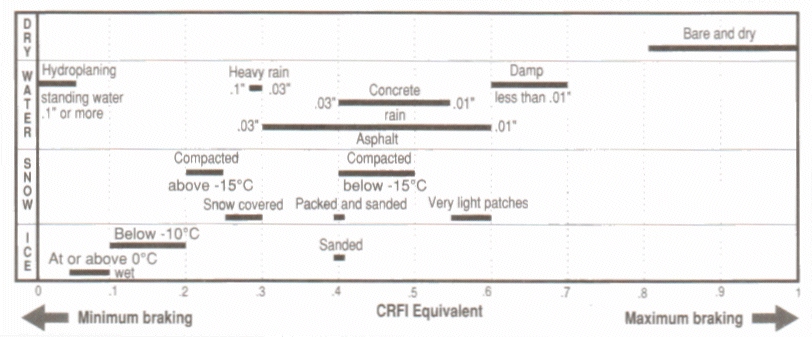
|
|
|
|
|
This week's topic:
Canadian Runway Friction Index
| Reported Canadian Runway Friction Index (CRFI) |
||||||||||||||
| Landing Distance (Feet) Bare and Dry Unfactored |
0.60 |
0.55 |
0.50 |
0.45 |
0.40 |
0.35 |
0.30 |
0.27 |
0.25 |
0.22 |
0.20 |
0.18 |
Landing Field
Length (Feet) Bare and Dry |
Landing Field
Length (Feet) Bare and Dry |
| Recommended Landing Distances (No Discing/Reverse Thrust) |
60% Factor |
70% Factor |
||||||||||||
| 1,800 |
3,120 |
3,200 |
3,300 |
3,410 |
3,540 |
3,700 |
3,900 |
4,040 |
4,150 |
4,330 |
4,470 |
4,620 |
3,000 |
2,571 |
| 2,000 |
3,480 |
3,580 |
3,690 |
3,830 |
3,980 |
4,170 |
4,410 |
4,570 |
4,700 |
4,910 |
5,070 |
5,250 |
3,333 |
2,857 |
| 2,200 |
3,720 |
3,830 |
3,960 |
4,110 |
4,280 |
4,500 |
4,750 |
4,940 |
5,080 |
5,310 |
5,490 |
5,700 |
3,667 |
3,143 |
| 2,400 |
4,100 |
4,230 |
4,370 |
4,540 |
4,740 |
4,980 |
5,260 |
5,470 |
5,620 |
5,880 |
6,080 |
6,300 |
4,000 |
3,429 |
| 2,600 |
4,450 |
4,590 |
4,750 |
4,940 |
5,160 |
5,420 |
5,740 |
5,960 |
6,130 |
6,410 |
6,630 |
6,870 |
4,333 |
3,714 |
| 2,800 |
4,760 |
4,910 |
5,090 |
5,290 |
5,530 |
5,810 |
6,150 |
6,390 |
6,570 |
6,880 |
7,110 |
7,360 |
4,667 |
4,000 |
| 3,000 |
5,070 |
5,240 |
5,430 |
5,650 |
5,910 |
6,220 |
6,590 |
6,860 |
7,060 |
7,390 |
7,640 |
7,920 |
5,000 |
4,286 |
| 3,200 |
5,450 |
5,630 |
5,840 |
6,090 |
6,370 |
6,720 |
7,130 |
7,420 |
7,640 |
8,010 |
8,290 |
8,600 |
5,333 |
4,571 |
| 3,400 |
5,740 |
5,940 |
6,170 |
6,430 |
6,740 |
7,110 |
7,550 |
7,870 |
8,100 |
8,500 |
8,800 |
9,130 |
5,667 |
4,857 |
| 3,600 |
6,050 |
6,260 |
6,500 |
6,780 |
7,120 |
7,510 |
7,990 |
8,330 |
8,580 |
9,000 |
9,320 |
9,680 |
6,000 |
5,143 |
| 3,800 |
6,340 |
6,570 |
6,830 |
7,130 |
7,480 |
7,900 |
8,410 |
8,770 |
9,040 |
9,490 |
9,840 |
10,220 |
6,333 |
5,429 |
| 4,000 |
6,550 |
6,780 |
7,050 |
7,370 |
7,730 |
8,170 |
8,700 |
9,080 |
9,360 |
9,830 |
10,180 |
10,580 |
6,667 |
5,714 |